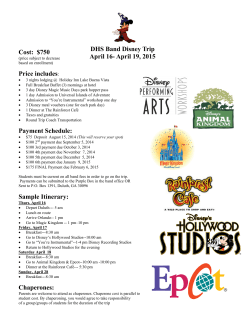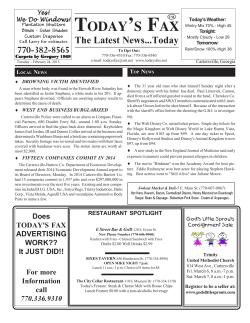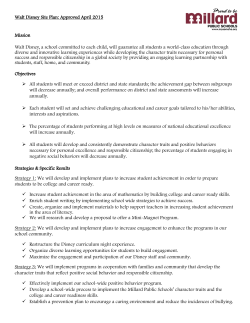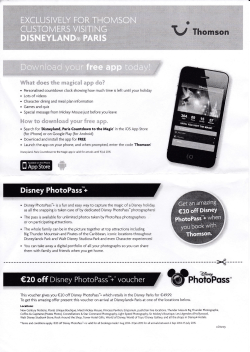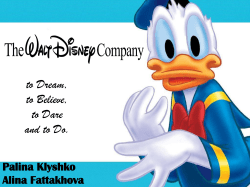
Disney-Pixar relationship dynamics
Organizational Dynamics (2011) 40, 43—48 a v a i l a b l e a t w w w. s c i e n c e d i r e c t . c o m journal homepage: www.elsevier.com/locate/orgdyn The Disney—Pixar relationship dynamics: Lessons for outsourcing vs. vertical integration ´ro ´lemy Je ˆme Barthe The choice between outsourcing and vertical integration is a crucial decision for many firms. However, there is no standard framework for making firm boundary decisions. Thus, it is often unclear for managers whether they should outsource or integrate an activity. An in-depth review of the academic literature suggests that three different approaches can help managers make successful firm boundary decisions. First, the ‘‘opportunism approach’’ is based on the assumption that suppliers may behave opportunistically towards their clients. Vertical integration is a way for clients to respond to such a threat. Second, the ‘‘competitive advantage approach’’ suggests that it is vital for firms to possess the resources and capabilities that offer the potential for competitive advantage. Outsourcing can be used to access all other resources and capabilities. Third, the ‘‘flexibility approach’’ considers the uncertainty associated with an activity. The greater the uncertainty, the better off firms are to use flexible arrangements such as outsourcing. While the three approaches are often used in isolation, only a simultaneous consideration of the opportunism approach, the competitive advantage approach and the flexibility approach can capture the full richness of firm boundary decisions. This paper proposes a framework that combines the three approaches. The operational nature of the framework is demonstrated by applying it to a symbolic case: the relationship between Disney and Pixar in 3D animated films. In 1991, Disney decided to outsource the production of 3D animated films to Pixar, while focusing on their marketing and distribution. Between 1995 and 2005, the films resulting from the Disney—Pixar partnership generated over $3 billion in box office takings worldwide. Over 150 million home videos (cassette tapes and DVDs) and countless articles of tie-in merchandising were also sold in a relationship that Steve Jobs, Pixar’s CEO, described as ‘‘one of the most successful in Hollywood history.’’ In 2006, Disney eventually bought its partner for $7.4 billion. Why did Disney first decide to outsource and subsequently to integrate the production of 3D animated films? Which approach played the most important role. Is the framework sufficient to account for all firm boundary decisions, or should other factors be taken into account? OUTSOURCING VS. VERTICAL INTEGRATION: A FRAMEWORK As pointed out above, an extensive review of the academic literature suggests that three approaches can be used to explain firm boundary decisions: the opportunism approach, the competitive advantage approach and the flexibility approach. In this section, each approach is described in greater detail. Their main recommendations are summarized in Table 1. The Opportunism Approach The most important contribution of the opportunism approach is that it takes into consideration potential opportunistic behaviors that may arise during a ‘‘client—supplier’’ relationship. Some suppliers are not just self-interested, but also opportunistic. For instance, they may make promises knowing well that they will break them in an instant, should the benefits from breaking them exceed the costs. According to the opportunism approach, suppliers are particularly likely to behave opportunistically in ‘‘small numbers’’ situations. The smaller the number of suppliers, the more dependent are clients on their suppliers. Suppliers may then take advantage of their clients’ dependence to behave opportunistically. In that case, it is recommended to use vertical integration rather than outsourcing. Arcelor Mittal is the world’s largest steelmaker. Over the past year, the company has bought several iron ore mines. The underlying rationale is straightforward. There are only three major suppliers for iron 0090-2616/$ — see front matter # 2010 Elsevier Inc. All rights reserved. doi:10.1016/j.orgdyn.2010.10.002 44 Table 1 J. Barthe ´lemy Outsourcing vs. vertical integration: a framework. Main recommendations Opportunism approach Competitive advantage approach Flexibility approach Use vertical integration when the threat of supplier opportunism is high Use outsourcing otherwise Use vertical integration when resources and capabilities offer potential for competitive advantage Use outsourcing otherwise Use outsourcing when the uncertainty surrounding an activity is high Use vertical integration otherwise ore worldwide. As Arcelor Mittal expects the demand for steel to increase, its objective is to become less dependent on suppliers. Indeed, suppliers may take advantage of rising demand and tighter supply to increase their prices. While a ‘‘small numbers bargaining’’ situation may exist from the start, it is important to note that it can also emerge in the course of a relationship when the client: (1) transfers specific resources to its supplier, and (2) makes relationspecific investments (i.e., investments that cannot be redeployed outside the relationship without losing a large proportion of their value). For instance, Lego, the Danish firm that commercializes the famous building blocks, outsourced most of its manufacturing activity in 2006. Hundreds of injection molding and packing machines were transferred to its supplier’s factories in Mexico and Hungary. In 2008, Lego decided to bring manufacturing back in-house. Because the machines used to produce and pack the building blocks are specific, outsourcing led to a ‘‘small numbers bargaining’’ situation. In addition, the specificity of the machines prevented the supplier from reaping significant economies of scale by using them for other clients. The Competitive Advantage Approach According to the competitive advantage approach, performance differences between firms are essentially a reflection of differences in terms of resources and capabilities. In general, four conditions must be met for resources and capabilities to generate a competitive advantage. They must: (1) create value, (2) be rare, (3) be difficult for competitors to imitate, and (4) be difficult to replace by other resources and capabilities. The competitive advantage approach has clear implications for outsourcing vs. vertical integration decisions. On the one hand, firms must absolutely possess the resources and capabilities that can provide them with a competitive advantage. Firms that outsource activities with high strategic value are doomed to become ‘‘hollow’’ corporations (and eventually fail). On the other hand, firms may use outsourcing to access resources and capabilities that do not offer the potential for competitive advantage. An additional advantage of outsourcing activities with limited strategic value is that it frees financial resources for integrating activities with high strategic value. Because design capabilities are crucial in notebook computers and consumer electronics, Apple performs this activity in-house. Manufacturing capabilities are less likely to generate a competitive advantage in this industry. Therefore, Apple outsources the manufacturing of products such as notebooks, iPod or iPhone to outside suppliers. Interestingly, the case of Apple can be contrasted with that of the Spanish chain of fashion stores Zara. In ‘‘fast fashion,’’ the ability to manufacture (and distribute) new items as quickly as possible is key to competitive advantage. Therefore, Zara is vertically integrated into the production (and distribution) of ‘‘fast fashion’’ items. On the other hand, Zara outsources the production of basic items that are more price-sensitive than time-sensitive to low-cost Asian suppliers. The Flexibility Approach Compared with the other two approaches, the main contribution of the flexibility approach is its emphasis on the role of uncertainty in outsourcing vs. vertical integration decisions. According to the flexibility approach, the higher the uncertainty associated with a particular activity, the better off a firm is to enter into a flexible arrangement such as outsourcing. On the one hand, it is often preferable to let suppliers make investments that may quickly become obsolete. For instance, the rapid development in IT outsourcing since the early-1990s can largely be explained by the reluctance of many firms to invest in equipment whose durability is by no means guaranteed. On the other hand, it is often preferable to have suppliers bear the cost of investments whose market outcomes are difficult to predict. This reasoning helps explain why many pharmaceutical firms outsource their biotechnology research and development (R&D) to specialized firms instead of focusing on a limited number of in-house research projects. The history of Hollywood film studios clearly shows how outsourcing can be used to deal with uncertainty. In the 1930s and the 1940s, cinema attendance was strong, and customer preferences were stable. Because studios could easily predict which stars, directors and film genres would be popular, they used to sign exclusive long-term contracts with stars. More generally, major studies were vertically integrated into the production and even the distribution of movies. With the advent of television in the 1950s, cinema attendance declined, and customer preferences became increasingly unpredictable. As a result, Hollywood studios started bringing together stars, directors and crews on a project basis instead of hiring them on a permanent basis. This highly flexible ‘‘Hollywood’’ system is still in use today. THE DISNEY—PIXAR RELATIONSHIP IN 3D ANIMATED FILMS In the early-1990s, Disney was a highly diversified firm with theme parks, TV channels, a publishing house, film studios, The Disney—Pixar relationship dynamics 45 film production and distribution companies, and a circuit of outlets for sales of tie-in merchandising. Its economic model essentially consisted of creating characters and capitalizing on them in all possible forms. In the case of the Lion King, for example, over 150 tie-in products were sold — not to mention home videos, theme park attractions and a stage musical. Pixar came into being in 1986, when Steve Jobs bought the computer-assisted animation division of Lucasfilm. Between 1986 and 1991, Pixar was involved in the production of TV commercials, music videos and video games. It also developed and licensed digital tools (RenderMan, Marionette and Ringmaster) to companies such as Disney, DreamWorks and Lucasfilm. Pixar began to attract public attention when it released Luxo Junior (the very first short film in 3D animation) and handled special effects for films such as Beauty and the Beast and Terminator 2. However, it essentially owed its survival to the financial support of Steve Jobs. Just as Steve Jobs was about to sell the company, he eventually succeeded in pushing through an agreement with Disney. In May 1991, Disney and Pixar signed an exclusivity contract for three full-length 3D animated films. Under the terms of the agreement, the films were to be made by Pixar and distributed by Disney. Disney, headed by Michael Eisner, would pay for all production and distribution costs, in return for a 12.5 percent fee on box office takings as distributor and 85 percent of takings as producer. Disney also held merchandising rights and the right to make sequels to the films created in collaboration with Pixar. On its release, Toy Story (1995) was considered revolutionary, both from a technological and artistic perspective. While animated films were traditionally aimed at children, Pixar’s films could be enjoyed by children, but also by teenagers and adults. Emboldened by this success, Steve Jobs threatened to end the relationship with Disney unless the contract terms were adjusted in Pixar’s favor. Eisner eventually agreed to renegotiate the contract in exchange for an extended duration. A new exclusivity contract for five films was signed in 1997 with the same allocation of roles, but considerable differences in the cost—benefit split. Under the new contract, Pixar would bear 50 percent of production costs in return for 50 percent of box office takings, and the profits on sales of tie-in merchandising would be shared equally between Disney and Pixar. The other clauses were unchanged. Disney also acquired 5 percent of the Pixar. Films made under the 1997 contract include A Bug’s Life (1998), Toy Story 2 (1999), Monsters, Inc. (2001) and, most Table 2 important, Finding Nemo (2003). Finding Nemo is Pixar’s greatest success to date. It knocked Disney’s The Lion King off the top of the rankings for the most profitable animated film in history. It also became the best-selling DVD ever for any film category. Meanwhile, Treasure Planet (2002), a 2D animation film entirely made by Disney, was a flop that resulted in a $100 million loss. Steve Jobs took advantage of this situation to make a new proposal to Disney in 2003. His objective was to strike a deal similar to the one that George Lucas had with Twentieth Century Fox for his Star Wars series. First, Pixar offered to pay all production costs in return for 100 percent of box office takings and full ownership rights to the films. Second, Pixar proposed to reduce the distribution fee from 12.5 percent to 7 percent. Third, Pixar asked for these new conditions to be applied retroactively to The Incredibles and Cars, two films covered by the 1997 contract. Steve Jobs justified this last demand as follows: ‘‘To fold the two remaining films into a new deal is consistent with common practice in Hollywood, where studios often grant such concessions to keep a valued partner. . . (It) would have mirrored the renegotiation of the contract between Disney and Pixar after Pixar’s first hit, ‘Toy Story’, under which the two remaining films from the old deal became the first two under a new contract.’’ After discussions lasting several months, Disney put forward the following counterproposal: box office takings should be split 70 percent for Pixar and 30 percent for Disney, after deduction of a distribution fee of 10 percent. While Pixar was prepared to raise the distribution fee, it would not budge on the respective shares of takings. Negotiations eventually broke down in February 2004 (which led some Disney board members to ask for the departure of Michael Eisner). Table 2 shows the breakdown of costs and benefits between Disney and Pixar in the 1991 agreement, the 1997 agreement and the various proposals and counterproposal made by the two partners in 2003 and 2004. Four studios were approached to handle the distribution of the films Pixar would make after the end of its contract with Disney: Twentieth Century Fox, Sony Pictures, Warner Bros and Universal. Contrary to expectations, no agreement was announced with any of these studios. Negotiations resumed with Disney following the arrival of a new CEO, Bob Iger. During the negotiations, Chicken Little (2005), the first 3D animated film made entirely by Disney, was only Breakdown of costs and benefits between Disney and Pixar. Cost Breakdown 1991 Agreement 1997 Agreement Pixar’s 2003 proposal Disney’s counterproposal for the Incredibles and Cars Pixar’s final proposal before negotiations broke down Distribution fee Profit breakdown (after deduction of the distribution fee) Disney Pixar Disney Disney Pixar 100% 50% 0 50% 0 50% 100% 50% 12.5% 12.5% 7% 10% 85% 50% 0 30% 15% 50% 100% 70% 0 100% Superior to 7% 0 100% Compiled by the author from various business press sources. 46 moderately successful. Its box office takings were lower than those of A Bug’s Life, the Pixar film that had registered the lowest audience figures. In January 2006, Disney announced the takeover of Pixar for 7.4 billion dollars (fifty times Pixar’s revenues, or the price of seventy Pixar films). The merger agreement stipulated that Disney was entitled to terminate the operation and demand $210 million in compensation if Ed Catmull (president of Pixar) or John Lasseter (executive vice-president of Pixar) resigned before the merger took place. With 6.5 percent of Disney’s capital, Steve Jobs became a board director at Disney and the company’s largest individual shareholder. After the takeover, Ed Catmull became president of both animation studios. Although they were renamed ‘‘Disney and Pixar Animation,’’ they did not truly merge. For instance, the Pixar teams did not move to join Disney’s teams in Burbank. The merger agreement also explicitly stipulated that the ‘‘Pixar Animation’’ logo on Pixar’s facilities in Emeryville would not be replaced by the ‘‘Disney and Pixar Animation’’ logo. Nevertheless, considerable pressure was put on Pixar. First, the pace of production was increased (seven films were announced for the period 2008—2013). Second, production costs had become so high (requiring $600 million in worldwide box office takings to break even) that each film had to be a ‘‘blockbuster’’ to be profitable. EXPLAINING THE DYNAMICS OF THE DISNEY— PIXAR RELATIONSHIP USING THE FRAMEWORK In this section, the framework is used to explain why Disney began by outsourcing the production of 3D animated films to Pixar in 1991, before deciding to acquire its partner in 2006. Pixar’s Opportunism The opportunism approach is sometimes questioned because it is grounded in a set of pessimistic assumptions about individuals. However, the fact that vertical integration can help deal with the opportunism of a supplier is clearly visible in the relationship between Disney and Pixar. Specifically, Disney’s takeover of Pixar can largely be explained by the increasing opportunism of Steve Jobs. After the success of Finding Nemo, Jobs demanded that the 1997 agreement should be reviewed in favor of Pixar. More important, he asked for the new terms to apply retroactively to The Incredibles and Cars. This behavior can be classified as opportunistic because the two films should have been governed by the 1997 contract (and not by a new one). In addition, they were already in production. Therefore, it is not surprising that Disney turned down Pixar’s offer. As its chief financial officer explained: ‘‘Disney management could not accept Pixar’s final offer because it would have cost Disney hundreds of millions of dollars it is entitled to under the existing agreement.’’ Consistent with the opportunism approach, it is essentially the ‘‘small numbers bargaining’’ situation that made it possible for Jobs to behave opportunistically. For Disney, the only alternative to Pixar was Dreamwork — the studio set up by Jeff Katzenberg after leaving Disney on acrimonious terms. To some extent, the takeover of Pixar was a way J. Barthe ´lemy for Disney to alleviate the increasing opportunism of its partner. As Steve Jobs commented after the merger: ‘‘Disney and Pixar can now collaborate without the barriers that come from two different companies with two different sets of shareholders.’’ Competitive Advantage in 3D Animation Technologies For the competitive advantage approach, vertical integration is primarily driven by the need to achieve a competitive advantage. This approach is very useful for explaining why Disney began by outsourcing the production of 3D animated films to Pixar before deciding to acquire its partner. In 1991, Disney did not have any expertise in 3D animation. At that time however, 3D animation capabilities were not required to possess a competitive advantage in the animated films industry. 2D animation was the dominant technology, and Disney was excellent at it. By 2006, the situation had radically changed. 3D animation capabilities had become vital to be successful in the animated film industry. Despite all its efforts, Disney had been unable to develop expertise in 3D animation in-house. Therefore, the takeover of Pixar was a way for Disney to integrate sorely needed 3D animation capabilities. It is important to note that the lack of technological capabilities was not the only reason for the takeover. Apart from skills in 3D animation skills, Disney also seemed to lack creativity. Under Michael Eisner, the company never really faced up to the change of paradigm that affected the animated film business. Only Pixar had managed to strike the perfect balance between the creative and technological facets of 3D animated films. As Ed Catmull pointed out in a Harvard Business Review interview: ‘‘When you go into other studios, you’ll find that most are either artistically driven or technically driven. We’ve tried hard to make sure that our technical people and creative people are peers. We’ve found that when the technology is strong, it inspires the artists. And when the artists are strong, they challenge the technology.’’ Uncertainty Around 3D Animation Technologies The flexibility approach is less frequently used than the opportunism approach and the competitive advantage approach. However, it seems to have a particularly strong explanatory power in the case of the Disney—Pixar relationship. In 1991, the big question was what sort of reception the audience would give an animated film made entirely with 3D technologies. It is important to remember that Tron (the first feature-length film mixing traditional animation and computer-generated imagery animation) had been an expensive flop for Disney in 1982. As the uncertainty around the potential of computer-generated imagery animation was high, Disney found it preferable to let a partner invest in this emerging technology. In other words, outsourcing the production of 3D animated films was a way for Disney to avoid risky investments in an unproven technology. As one success followed another, the uncertainty surrounding 3D animation progressively melted away. Apart from a few exceptions (notably the films by Hayao Miyazaki The Disney—Pixar relationship dynamics such as Spirited Away or Howl’s Moving Castle), 3D has clearly supplanted 2D in the animated film business. As the need for flexibility disappeared, the benefits of outsourcing (as compared to vertical integration) also decreased. LESSONS FROM THE DISNEY—PIXAR RELATIONSHIP There is no accepted framework for making firm boundary decisions. Thus, it is often difficult for managers to determine whether they should outsource or integrate an activity. The framework proposed in this article suggests that three different approaches must be simultaneously considered to make successful outsourcing or vertical integration decisions: the opportunism approach, the competitive advantage approach and the flexibility approach. The Disney—Pixar relationship between 1991 and 2006 clearly illustrates the framework. Taken individually, no approach can fully analyze the dynamics of the Disney—Pixar relationship. However, the framework suggests that outsourcing the production of 3D animated films made sense for Disney in 1991 because: (1) Pixar was unlikely to behave opportunistically, (2) there was a lot of uncertainty around the potential of 3D animation, and (3) 2D animation capabilities were far more likely to generate a competitive advantage than 3D animation capabilities. By 2006, vertical integration had become necessary for Disney because: (1) Pixar was taking advantage of its dependence to behave opportunistically, (2) the uncertainty surrounding 3D animation had disappeared, and (3) 3D animation capabilities had even become key to competitive advantage in the animated film industry. Lessons from the Disney—Pixar relationship are straightforward. First, a firm should use vertical integration when there is a threat of being unfairly exploited by its supplier. Otherwise, it is safe to use outsourcing. Second, a firm should use vertical integration for activities with high strategic value (cf. activities based on resources and capabilities that generate a competitive advantage). Only activities with limited strategic value should be outsourced. Third, outsourcing is generally a more flexible option than vertical integration. Hence, firms should use outsourcing when the environment is uncertain. It is worth noting that the framework sometimes leads to contradictory recommendations for managers. For instance, the threat of opportunism may be high (suggesting vertical integration), whereas the level of uncertainty may also be high (suggesting outsourcing). Likewise, the potential for competitive advantage may be high (suggesting vertical integration), whereas the level of uncertainty may also be high (suggesting outsourcing). In such cases, decisions to use outsourcing or vertical integration will depend on the weights placed by managers on the three approaches. While various contingencies may influence how managers weigh and act on 47 the three approaches, risk orientation is a particularly important one. For instance, ‘‘risk averse’’ managers will be reluctant to outsource an activity when the threat of opportunism is high, no matter the level of uncertainty. Even when the framework suggests that outsourcing is feasible, it must be kept in mind that successful outsourcing also requires an ability to select and control suppliers. For instance, Boeing had always designed and built its planes inhouse. Following the September 11 terrorist attacks however, Boeing top executives were unwilling to invest over $10 billion to develop a new plane. To increase flexibility, they made the decision to outsource most of the 787 Dreamliner’s manufacturing to a global network of over 50 suppliers. Only final assembly would be performed by Boeing, using modules provided by the suppliers. Because manufacturing was outsourced to over 50 suppliers worldwide, the potential for supplier opportunism was low. To avoid losing competitive advantage, Boeing also kept final assembly in-house. Only the production and some of the design of the modules were outsourced. Today, the project is over two years behind schedule. A major reason for the delay is that Boeing was not sufficiently prepared, and somehow lost control over its suppliers. In addition, some suppliers were unable to live up to the expectations of Boeing. As a result, Boeing has brought back major production lines in-house and hired engineers to oversee its suppliers. Finally, it is important to note that other factors also have a decisive influence on outsourcing vs. vertical integration decisions. In the Disney—Pixar relationship, the adversarial relationship between Steve Jobs and Michael Eisner helps explain why the negotiations broke up in 2004. Conversely, Pixar’s decision to accept Disney’s takeover offer in 2006 was partly due to Jobs’ health problems. As Galyn Susman, associate producer of the Ratatouille film, revealed at a conference of the Amis de l’Ecole de Paris in 2007: ‘‘About four years ago, Pixar was about to go completely independent from our distribution and marketing deal with Disney and do it on our own. We were considering having someone else do the distribution, but we would do everything else, including all of the marketing. Then Steve was diagnosed with cancer, and upon his recovery I think he realized he needed to do only one company and spend more time with his family. Pixar was sold to Disney. He’s the largest individual shareholder of Disney. He sits on the board and holds an enormous amount of sway. But he’s no longer involved in the day-to-day workings of Pixar.’’ Whatever its accuracy, a framework will never be able to contain all aspects of reality. Every situation is unique and specific factors must be taken into consideration. 48 J. Barthe ´lemy SELECTED BIBLIOGRAPHY The methodology used to develop the case study is based on D. Stewart and M. Kamins, Secondary research: Information sources and methods (2nd edition) (Sage Publications: Newbury Park, 1993). First, the Ebsco and Factiva databases were systematically consulted via the keywords ‘‘Disney’’ and ‘‘Pixar’’ to retrieve all articles that had been written on the Disney—Pixar relationship. To ensure that these ‘‘external’’ secondary data were reliable, only data that could be verified by comparison with at least two non-anonymous sources were selected. Second, ‘‘internal’’ secondary data were collected from annual reports and Web sites. Third, various books published on Disney, Pixar and Apple were consulted. Recent examples include D. Price, The Pixar Touch: The Making of a Company, (New York: Knopf, 2008) and J. Young and W. Simon, iCon–—Steve Jobs: The Greatest Second Act in the History of Business (Chichester: Wiley, 2005). An analysis of value creation and appropriation mechanisms in the Disney—Pixar relationship can also be found in J. Barthe ´lemy, ‘‘Cre ´ation et Appropriation de Valeur Dans un Partenariat: Le Cas Disney—Pixar,’’ Revue Franc¸aise de Gestion, May 2006, 141—155. For recent papers using the three theoretical approaches, see for instance M. Leiblein, ‘‘The Choice of Governance Form and Performance: Predictions from Transaction Cost, Resource-Based and Real Options Theories,’’ Journal of Man- agement, 2003, 29, 937—961; K. Steensma and K. Corley, ‘‘Organizational Context as a Moderator of Theories on Firm Boundaries for Technology Sourcing,’’ Academy of Management Journal, 2001, 44, 271—291; M. Schilling and K. Steensma, ‘‘Disentangling the Theories of Firm Boundaries: A Path Model and Empirical Test,’’ Organization Science, 2002, 13, 387—401. Classic references on each of the theoretical approaches include: opportunism approach: O.E. Williamson, The Economic Institutions of Capitalism (New York: Free Press, 1985); O.E. Williamson, Market and Hierarchies: Analysis and Antitrust Implications (New York: Free Press, 1975); competitive advantage approach: J. Barney, ‘‘Firm Resources and Sustained Competitive Advantage,’’ Journal of Management, 1991, 17, 99—120; B. Wernerfelt, ‘‘A Resource-Based View of the Firm,’’ Strategic Management Journal, 1984, 5, 171—180; flexibility approach: T. Folta, ‘‘Governance and Uncertainty: The trade-off Between Administrative Control and Commitment’’, Strategic Management Journal, 1998, 19, 1007—1028; B. Kogut, ‘‘Joint Ventures and the Option to Expand and Acquire,’’ Management Science, 1991, 37, 19—33. ´ro ´lemy is a professor of management at ESSEC Business School Paris (France). He holds a Ph.D from Je ˆme Barthe HEC Paris (France) and has been a visiting research scholar at Stanford University and Cambridge University. His research on outsourcing and franchising has appeared in journals such as Strategic Management Journal, Journal of Business Venturing, Journal of Management Studies and MIT Sloan Management Review. He is also the editor in chief of the Revue Franc¸aise de Gestion. You can reach him at ESSEC Business School Paris, 95021 Cergy Pontoise Cedex, France (Tel.: +33 1 34 43 31 98; fax: +33 1 34 43 30 01, email: barthelemy@essec.fr).
© Copyright 2025
